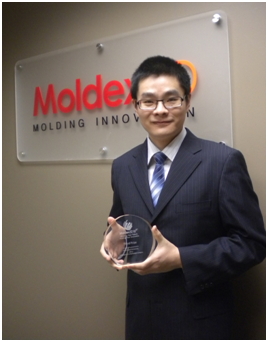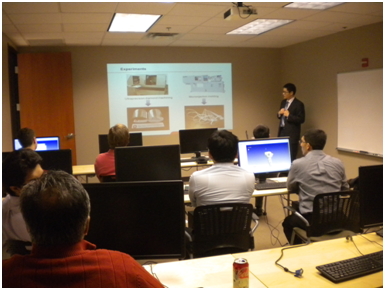![]() Read the full winning entry
Read the full winning entry ![]() Browse 2013 winners’ gallery
Browse 2013 winners’ gallery
 Q: How do you feel about winning the 2013 Moldex3D Global Innovation Talent Award Contest?
Q: How do you feel about winning the 2013 Moldex3D Global Innovation Talent Award Contest?
Likai Li: I really appreciate the opportunity to show the research we do at OSU. I feel very excited about the results. This recognizes the time and effort that we put into the project. We will continue to contribute to the manufacturing community.
Q: How did you find out about the contest and what is the driving force behind that made you enter it?
Likai Li: My driving force is that I want to share my research with my colleagues and the outside community. We want to expand past academia, publish our research and let everyone know about how we contribute.
Q: How did you get the idea of using Moldex3D to optimize manufacturing processes?
Likai Li: I got the idea from prior knowledge of Moldex3D and its capabilities. I know that Moldex3D reduces the costs of doing experimentation. We don’t always know what the actual results of experimentation will be. However, by using Moldex3D we can visualize how the plastic moves inside the cavity.
Q: What was the greatest challenge during the project? Are there any pain points that you’d like to share with us? And how did you overcome them?
Likai Li: My project was to combine the optics theory and the injection molding process. It is difficult to describe how the optical phenomenon is affected. We want to find the factors the injection molding process that influence optics. Because the software is mainly provided by the user, we are middleman between the process and optical engineers. We need to figure out how to use the information and apply it to the optics theory. Usually the optics theory is only applied to the uniform refractive index distribution and regular geometry. Incorporating the non-uniform refractive index distribution and deformed geometry is a major challenge. We finally overcame this by finding a method that included all of the factors. We then used that to calculate the optical aberration.
The greatest value of this research project is that it demonstrates how simulation can reduce the manufacturing cost and maintain the optics precision at the same time.
 Likai Li presented his research project at Moldex3D North America Open House event
Likai Li presented his research project at Moldex3D North America Open House event
Q: What is the greatest value of this research project?
Likai Li: Usually progressive addition lenses are made by casting. Injection molding introduces many unstable factors. While introducing the simulation analysis to this process, those drawbacks can be predicted and eventually minimized by the simulation. The greatest value of this research project is that it demonstrates how simulation can reduce the manufacturing cost and maintain the optics precision at the same time.
Q: Any plans for your project going forward?
Likai Li: We want to further develop this process to industrialize it. Right now, it is still on the research level. We are confident that this will have a lot of industrial potential if we keep improving the entire process.
